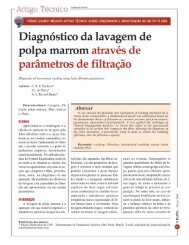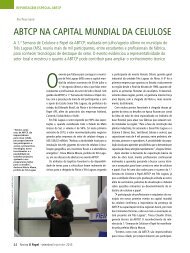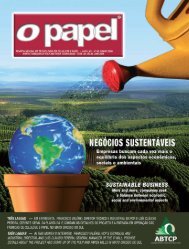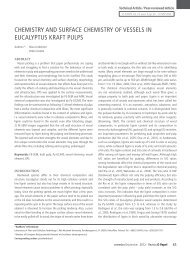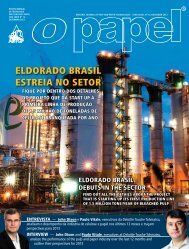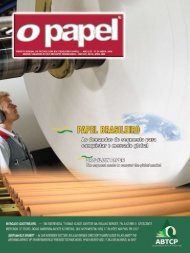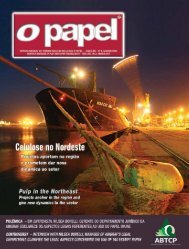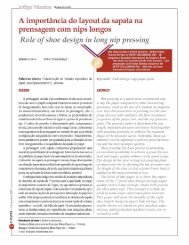You also want an ePaper? Increase the reach of your titles
YUMPU automatically turns print PDFs into web optimized ePapers that Google loves.
Technical Article / Peer-reviewed Article<br />
O PAPEL vol. 73, num. 7, pp. 57 - 65 JUL 2012<br />
1992, Hammar et al., 2000, Laivins, Scallan, 2000, Bäckström et<br />
al., 2009 a). Electrostatic repulsion of negatively charged groups<br />
is the cause of swelling according to the theory of charged<br />
electrolytic gels (Flory, 1953). According to Bjellfors et al.,<br />
(1965), the shear strength and shear modulus of a fibre network<br />
are influenced by the counterion to the charged groups, where<br />
fibres in the Na + -form have a lower shear modulus than fibres in<br />
H + -, Ca 2+ -, Al 3+ - or Th 4+ -forms. A tentative explanation is that the<br />
cations affect the interaction between fibres and the flocculation<br />
process, and thus influence the shear modulus of the network.<br />
It has been shown in the literature that handsheets made from<br />
fibres with carboxyl groups in different ionic forms have different<br />
tensile indexes, where fibres in the Na + -form had the highest tensile<br />
index and swelling ability, while hydrogen and aluminium counterions<br />
gave less swelling and a poorer strength (Scallan, Grignon, 1979).<br />
Hammar et al., (2000) separated the effects of counterion on refining<br />
and sheet formation by refining pulps in different ionic forms and<br />
then converting all the pulps into the Ca 2+ ‐form prior to papermaking.<br />
Their results showed that the energy required to reach a given WRV<br />
(water retention value) or a given tensile index could be reduced by<br />
50% if the fibres were refined in the Na + -form. The results have been<br />
confirmed in a pilot scale study (Bäckström et al., 2009a). Additional<br />
energy savings are possible if the sheet formation is performed in the<br />
Na + -form (Hammar et al., 2000).<br />
The objective of the present study was to investigate if the<br />
improved refinability - in this case the required refining energy<br />
input to reach a given WRV - of fibres in the Na + -form could be<br />
related to changes in floc network strength or if it was related<br />
to the fibre, in terms of fibrillation characteristics. The fibre<br />
network strength for unrefined and laboratory refined pulp of an<br />
unbleached never-dried kraft pulp in different ionic forms was<br />
studied using a parallel plate rheometer. The degree of external<br />
fibrillation was also studied using three different techniques.<br />
MATERIALS AND METHODS<br />
Materials<br />
Never-dried unbleached kraft pulp from Skärblacka mill, Billerud,<br />
Sweden, was used. The kappa number was 31 and the amount of<br />
charged groups was 130 mmol/kg. The length-weighted fibre length<br />
of the pulp was 2.54 mm.<br />
The pulp was washed with deionized water in order to remove<br />
the remaining chemicals from the cooking process; after that, the<br />
pulp was centrifuged, homogenized and stored in a cold room.<br />
Ion exchange<br />
The whole pulp was changed to the H + -form by addition of<br />
H 2<br />
SO 4<br />
for 2 h at pH 2. The H 2<br />
SO 4<br />
was removed by washing with<br />
deionized water until the recirculation system reached a low<br />
conductivity (close to that of deionized water). Parts of the pulp<br />
were then converted into the Na + - and Ca 2+ -forms. The chemicals<br />
used in the ion exchange process and the washing liquor are<br />
listed in Table 1. After the ion exchange had been carried out,<br />
the ionic form of the pulp was verified by metal content analysis<br />
of the original H + -, Na + - and Ca 2+ -forms pulps.<br />
Refining conditions<br />
The refining was performed in an Escher Wyss laboratory<br />
conical refiner R 1L at a pulp consistency of 3.5% and at a<br />
specific edge load (SEL) of 2 Ws/m at four different specific<br />
energy inputs: 50, 75, 100 and 125 kWh/t in deionized water.<br />
Analysis<br />
The total charge of the pulps was determined by conductimetric<br />
titration according to Katz (1984). Prior to the measurement,<br />
the sample was washed with HCl at a pH 2. Thereafter, the<br />
sample was washed with deionized water until the filtrate had a<br />
conductivity less than 5 µS/cm and a pH higher than 4.5.<br />
Kappa number was determined according to IS0 302:2004<br />
and the WRV according to SCAN –C 62:00, except that deionized<br />
water was used. The WRV is calculated as the wet weight after<br />
centrifugation subtracted by the dry weight after centrifugation,<br />
and then divided by the dry weight after centrifugation, i.e.<br />
weight of water per weight of sample. The °SR (Schopper-<br />
Riegler) number according to ISO 5267-1, and metal analysis<br />
were performed using plasma emission spectrometry ICP-AES.<br />
Fibre dimensions and shape factor were determined using the<br />
STFI FiberMaster (Karlsson et al., 1999). Fibre bendability was<br />
measured using the FiberMaster where the shape factor of the<br />
fibres was measured at two different flow rates (Fransson et<br />
al., 1992). The STFI FiberMaster used municipal water in the<br />
measuring cell.<br />
Table 1. Chemicals, pH and washing medium employed in the ion-exchange procedure<br />
Ionic<br />
form<br />
Chemical in<br />
ion exchange<br />
pH during<br />
ion exchange<br />
Washing<br />
medium<br />
pH (20ºC)<br />
after refining<br />
H + H 2<br />
SO 4<br />
2 Deionized water ~5<br />
Na + NaOH 10.5 0.0001mol/L NaHCO 3<br />
, pH9 ~8<br />
Ca 2+ CaCl 2<br />
8 Deionized water ~7<br />
58 <strong>Revista</strong> O <strong>Papel</strong> - julho/July 2012



